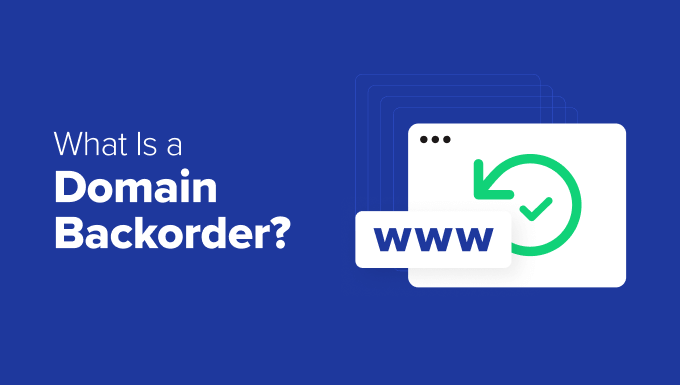I once watched someone lose out on their dream domain simply because they didn’t know about domain backordering. They had waited patiently for months, hoping the domain would expire—only to have someone else snap it up the moment it became available.
Over the years, I’ve helped countless website owners successfully claim high-value domain names through backordering. I’ve experimented with different registrars and services, and I’ve learned what works—and what doesn’t—when it comes to securing expiring domains.
If you’re eyeing a domain that’s already taken, this guide will show you exactly how domain backordering works and how to boost your chances of getting that perfect name.

What Is Domain Backordering (And Why It Matters)?
Every day, thousands of domain names expire and become available for re-registration. But many people don’t realize there’s a proactive way to claim these names before someone else gets to them.
That’s where domain backordering comes in.
So, What Exactly Is Domain Backordering?
Domain backordering is a service that attempts to register a domain name on your behalf the moment it becomes available. Think of it as putting yourself on a waiting list for a highly coveted ticket—ready to grab it the second it’s up for grabs.
By placing a backorder, you’re essentially reserving your spot in line for a domain that’s currently owned by someone else. And when everything lines up, finally landing that ideal domain is an incredibly rewarding feeling.

Why Would You Backorder a Domain?
Sometimes you come up with the perfect domain name for your blog, business, or online store—only to find out it’s already taken. Maybe it’s not being used actively, or worse, it’s just sitting parked and gathering digital dust. That’s where domain backordering can make a big difference.
Here are a few reasons you might consider backordering a domain:
- Snag a premium domain that’s currently owned by someone else.
- Save money compared to negotiating with the current owner, who might be asking a steep price.
- Let professionals do the work of tracking and grabbing the domain the moment it becomes available.
- Increase your chances of success by using multiple backordering services.
💡 Pro Tip: Want to improve your odds even more? Check out my guide on how to buy a domain name that’s already taken — it’s packed with insider tips.
Challenges of Domain Backordering
Domain backordering is powerful, but it’s not a silver bullet. There are some challenges and risks to be aware of.
- No guarantees. You’re likely not the only one eyeing that domain. If multiple people place backorders on the same domain, it may go to auction—sometimes driving the price way beyond your budget.
- Unsuccessful attempts may still cost you. Some services charge even if the domain isn’t secured.
- The current owner might renew. Domains can be renewed at the last minute, sending you right back to square one.
Still, if you’re okay with the risk, the payoff can be well worth it. I’ve gone through this process multiple times—for myself and others—and it can absolutely work.
So, what have you got to lose?
What This Guide Will Cover
Here’s a quick breakdown of what you’ll learn in the rest of this article:
- The Domain Registration Life Cycle: Understanding the timing behind domain expiration.
- How to Research a Domain Before Backordering
- How to Choose the Right Backorder Service
- Top Domain Backordering Services Compared
- Step-by-Step: Placing a Backorder Properly
- Tracking the Progress of Your Backorder
- Possible Outcomes and What to Do Next
- Alternatives to Backordering
- FAQs About Domain Backorders
- Additional Resources on Buying Domains
By the end, you’ll know exactly how domain backordering works—and how to dramatically improve your chances of securing the domain you’ve been dreaming about.
The Domain Registration Life Cycle: Timing Is Everything
One of the biggest keys to a successful backorder is timing. But how do you know when the right moment is?
To answer that, let’s take a look at how domain names progress through their lifecycle:
1. Active Registration
A domain is registered for a fixed term—typically between 1 to 10 years. During this period, the owner has full control and can renew it at will.
2. Expiration & Grace Period
When the domain registration expires and the owner doesn’t renew, it enters a Grace Period (usually 30–45 days). During this time, the owner can still renew it without penalty.
3. Redemption Period
If the domain isn’t renewed during the Grace Period, it moves into a Redemption Period (another 30 days or so). The owner can still reclaim it, but only by paying a hefty redemption fee—often $100–$200.
4. Pending Delete
Once the Redemption Period ends, the domain enters Pending Delete, which lasts about 5 days. At this stage, no one—not even the original owner—can make changes or renew it. It’s scheduled for deletion.
5. Domain Becomes Available
When the Pending Delete phase ends, the domain is finally deleted and becomes publicly available for registration. This is the exact moment when backordering services try to grab it for you.
Here’s a simple visual you can refer to as you track a domain’s journey through the lifecycle:
(Illustration would go here—let me know if you’d like help designing a visual graphic.)

